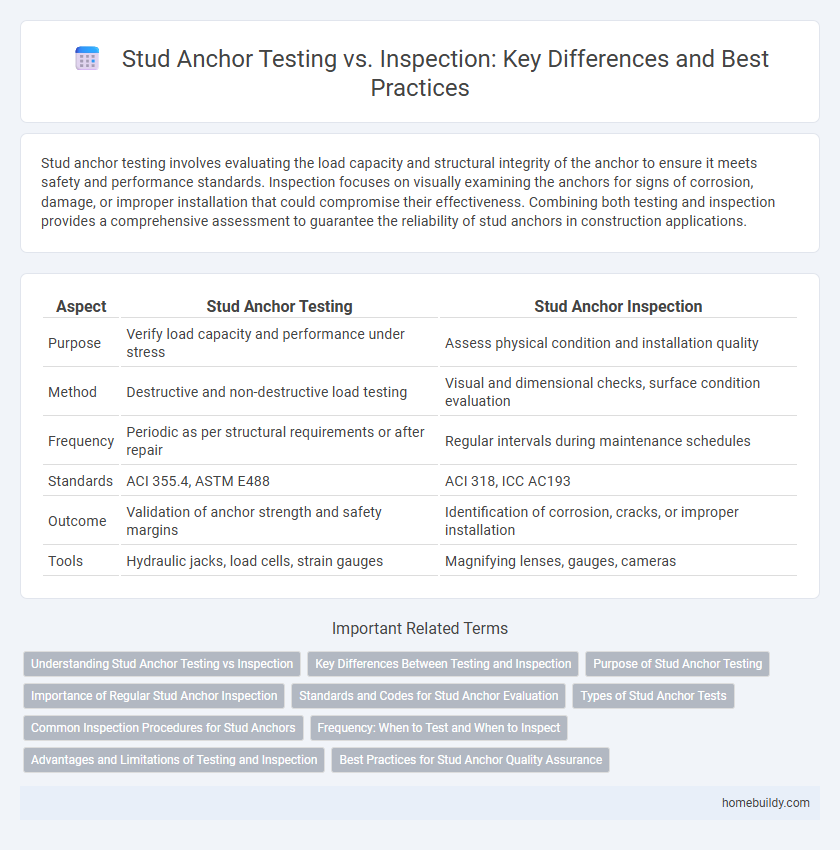Stud anchor testing involves evaluating the load capacity and structural integrity of the anchor to ensure it meets safety and performance standards. Inspection focuses on visually examining the anchors for signs of corrosion, damage, or improper installation that could compromise their effectiveness. Combining both testing and inspection provides a comprehensive assessment to guarantee the reliability of stud anchors in construction applications.
Table of Comparison
| Aspect | Stud Anchor Testing | Stud Anchor Inspection |
|---|---|---|
| Purpose | Verify load capacity and performance under stress | Assess physical condition and installation quality |
| Method | Destructive and non-destructive load testing | Visual and dimensional checks, surface condition evaluation |
| Frequency | Periodic as per structural requirements or after repair | Regular intervals during maintenance schedules |
| Standards | ACI 355.4, ASTM E488 | ACI 318, ICC AC193 |
| Outcome | Validation of anchor strength and safety margins | Identification of corrosion, cracks, or improper installation |
| Tools | Hydraulic jacks, load cells, strain gauges | Magnifying lenses, gauges, cameras |
Understanding Stud Anchor Testing vs Inspection
Stud anchor testing evaluates the structural integrity and load capacity of installed anchors under simulated or actual stress conditions, ensuring compliance with safety standards and design specifications. Inspection involves a detailed visual and dimensional assessment to identify corrosion, installation defects, or damage that could compromise performance without applying load. Understanding the distinction between testing, which validates strength, and inspection, which detects physical anomalies, is crucial for maintaining the reliability of stud anchor applications in construction and engineering.
Key Differences Between Testing and Inspection
Stud anchor testing involves applying controlled loads to verify the structural capacity and performance under real stress conditions, ensuring the anchor meets design specifications. Inspection focuses on visual and non-destructive evaluation methods to identify surface defects, corrosion, or installation errors without applying stress. The key difference lies in testing validating functional performance under load, while inspection assesses physical condition and compliance without load application.
Purpose of Stud Anchor Testing
Stud anchor testing evaluates the mechanical strength and load-bearing capacity of the anchor to ensure it meets safety and design specifications. The testing process identifies potential defects or weaknesses that could compromise structural integrity under operational stresses. This verification helps prevent anchor failure, ensuring long-term durability and reliability in construction applications.
Importance of Regular Stud Anchor Inspection
Regular stud anchor inspection is essential to ensure structural integrity and prevent catastrophic failures in construction and engineering projects. Detecting corrosion, fatigue, or installation defects early through non-destructive testing methods helps maintain load-bearing capacity and extends the lifespan of stud anchors. Consistent inspection schedules aligned with industry standards such as ASTM E165 guarantee safety compliance and operational reliability.
Standards and Codes for Stud Anchor Evaluation
Standards and codes such as ACI 355.2 and ACI 318 provide rigorous criteria for stud anchor testing and inspection, ensuring structural safety and reliability. These guidelines emphasize both qualification testing, including tension and shear tests under controlled conditions, and periodic inspection in the field to detect potential degradation or damage. Compliance with these standards is essential for the accurate evaluation of load capacity, durability, and performance of stud anchors in concrete structures.
Types of Stud Anchor Tests
Stud anchor testing involves several types to ensure optimal performance and safety, primarily including pull-out tests, torque tests, and fatigue tests. Pull-out tests measure the ultimate load capacity of the anchor by applying tension until failure, while torque tests assess the installation quality by measuring resistance during tightening. Fatigue tests evaluate the anchor's durability under cyclic loading, crucial for structures subject to dynamic forces.
Common Inspection Procedures for Stud Anchors
Common inspection procedures for stud anchors include visual examination to identify corrosion, cracks, or deformation, ensuring anchorage integrity and safety compliance. Ultrasonic testing and magnetic particle inspection are often employed to detect subsurface defects and material discontinuities in critical structural applications. Torque testing and pull-out tests validate the anchorage strength and confirm that the installation meets specified design standards and load requirements.
Frequency: When to Test and When to Inspect
Stud anchor testing is typically required upon installation and after any significant structural changes or events to ensure safety and compliance with engineering standards. Routine inspections should occur at regular intervals, commonly every 6 to 12 months, to identify visible signs of corrosion, wear, or damage that could compromise performance. Testing frequency depends on factors such as load conditions, environmental exposure, and manufacturer recommendations, with inspections serving as a preventative measure between testing intervals.
Advantages and Limitations of Testing and Inspection
Stud anchor testing provides precise data on load-bearing capacity, ensuring structural safety through applied stress verification, which surpasses visual inspection's surface-level assessment. Inspection excels in identifying visible defects, corrosion, or installation errors without requiring complex equipment, offering a quick and cost-effective evaluation method. However, testing can be time-consuming and disruptive, while inspections may miss internal flaws or strength deficiencies, highlighting the importance of combining both for comprehensive quality assurance.
Best Practices for Stud Anchor Quality Assurance
Stud anchor testing involves rigorous pull-out strength and torque resistance assessments to ensure structural integrity and load capacity compliance. Inspection procedures include visual checks for corrosion, thread damage, and proper embedment depth, critical for long-term performance and safety assurance. Implementing standardized testing protocols alongside regular inspections guarantees consistent quality control and adherence to construction standards.
Stud anchor testing vs inspection Infographic

 homebuildy.com
homebuildy.com